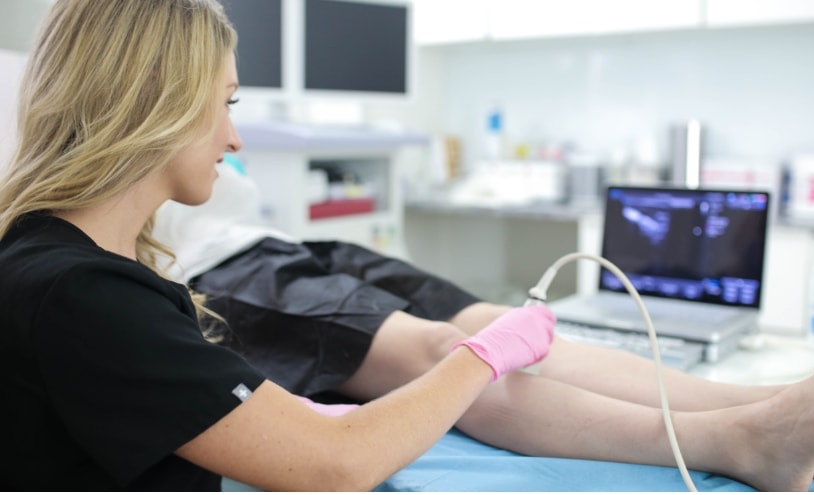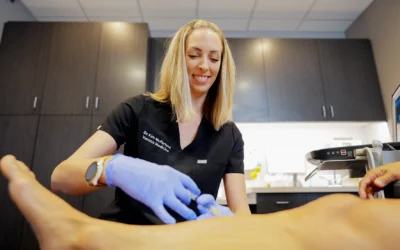Top Maryland Vein Doctors
How Long Does The VenaSeal Procedure Take? Procedure, Benefits, Side Effects, and More
How long does the VenaSeal procedure take?
The VenaSeal procedure is a non-surgical treatment for varicose veins that typically takes about 45 minutes to one hour to complete. The procedure is performed in a vein doctor’s office or outpatient setting and does not require downtime.
Maryland Vein Treatment is a state-of-the-art medical center specializing in the latest and safest minimally invasive varicose vein treatments, including VenaSeal. Our medical center is led by board-certified vein doctors specializing in comprehensive diagnosis and treatment for the root cause of vein problems. We have a flawless track record because of our considered approach to vein care. If you live in the District, please visit our medical center for vein treatment at 10215 Fernwood Rd, Suite 301, Bethesda. Please schedule an appointment online.
What is the VenaSeal treatment for varicose veins?
Varicose veins are enlarged, twisted veins that can occur in the legs and are often visible, protruding from the skin’s surface. They can cause discomfort, aching, and swelling and lead to more serious health problems if left untreated. The VenaSeal procedure is a treatment for varicose veins that uses a medical adhesive to seal the affected vein closed.
During the procedure, your vein doctor will use ultrasound to locate the affected vein and apply the medical adhesive through a small catheter. The adhesive seals the vein closed, redirecting blood flow to healthy veins. The procedure is minimally invasive and does not require any incisions. Over time, the diseased vein gets reabsorbed by the body.
What are the benefits of the VenaSeal procedure?
The VenaSeal procedure has several benefits compared to other treatments, including:
- Minimally invasive: The VenaSeal procedure is non-surgical and does not require incisions, making it less invasive than surgical treatments, such as vein stripping.
- Quick recovery time: Because the VenaSeal procedure is minimally invasive, patients typically experience a quick recovery time with no downtime. Most patients can resume normal activities on the same day as the procedure.

We know health insurance is confusing so we will help you check if you’re covered:
FREE Coverage Checker:
Like any medical procedure, the VenaSeal procedure carries the risk of side effects. The most common side effects of the VenaSeal procedure include bruising, swelling, and discomfort at the site of the adhesive application. These side effects are typically mild and resolve on their own within a few days to a week.
Less common side effects of the VenaSeal procedure include allergic reactions to the adhesive, bleeding, infection, and the formation of blood clots. These rare side effects can typically be managed with proper medical care. You must discuss the potential risks and benefits of the VenaSeal procedure with your vein doctor before deciding if the treatment is right for you. Your vein specialist can help you understand the potential side effects and make an informed decision about your treatment options.
What are the side effects of VenaSeal?
Like any medical procedure, the VenaSeal procedure carries the risk of side effects. The most common side effects of the VenaSeal procedure include bruising, swelling, and discomfort at the site of the adhesive application. These side effects are typically mild and resolve on their own within a few days to a week.
Less common side effects of the VenaSeal procedure include allergic reactions to the adhesive, bleeding, infection, and the formation of blood clots. These rare side effects can typically be managed with proper medical care. You must discuss the potential risks and benefits of the VenaSeal procedure with your vein doctor before deciding if the treatment is right for you. Your vein specialist can help you understand the potential side effects and make an informed decision about your treatment options.
What are the possible VenaSeal complications?
As with any medical procedure, the VenaSeal procedure carries the risk of complications. The most common complications of the VenaSeal procedure include allergic reactions to the adhesive, bleeding, infection, and the formation of blood clots. Generally speaking, you can avoid the complications of VenaSeal by working with a skilled, board-certified vein doctor.
How long should I wear compression stockings after VenaSeal?
Compression stockings are a type of clothing worn to improve blood flow and reduce swelling in the legs. They are often recommended after the VenaSeal procedure to reduce swelling and discomfort, help the treated vein heal properly, and prevent blood accumulation in the veins.
The length of time that you should wear compression stockings after the VenaSeal procedure will depend on your individual circumstances and the recommendations of your vein doctor. In general, it’s recommended to wear compression stockings for the first few days after the procedure to reduce swelling. Your vein doctor may recommend that you continue wearing compression stockings for longer to support healthy blood flow in the treated area and minimize the risk of vein disease recurrence.

Visit Our Maryland Vein Treatment Center
Can you walk after VenaSeal?
Yes, most patients can walk after the VenaSeal procedure. The VenaSeal procedure is minimally invasive and does not require incisions, so patients experience minimal discomfort and a quick recovery. There’s no downtime. You can resume your daily activities and work immediately, but please avoid strenuous activity for a few days after the procedure to allow the treated vein to heal properly. You must also follow the vein doctor’s aftercare instructions accurately.
Are you awake for VenaSeal?
Yes, the VenaSeal procedure is performed while you are awake. The procedure is minimally invasive and does not require general anesthesia, so you’ll be completely awake. During the procedure, the vein doctor will use ultrasound to locate the affected vein and channel the adhesive through a small catheter to close the diseased vein. You’ll experience minimal discomfort during the treatment, so there’s no need for general anesthesia.
How is the VenaSeal procedure prepared?
Before the VenaSeal procedure, your vein doctor will perform a physical examination and review your medical history to determine if the procedure is appropriate for you. You may also need imaging tests, such as duplex ultrasound, to evaluate the affected vein and determine the best treatment approach. You will be asked to wear a gown during the procedure and to remove any jewelry or other items that may interfere with the procedure. Please follow the instructions of your vein doctor before the procedure to ensure a safe and successful treatment.



